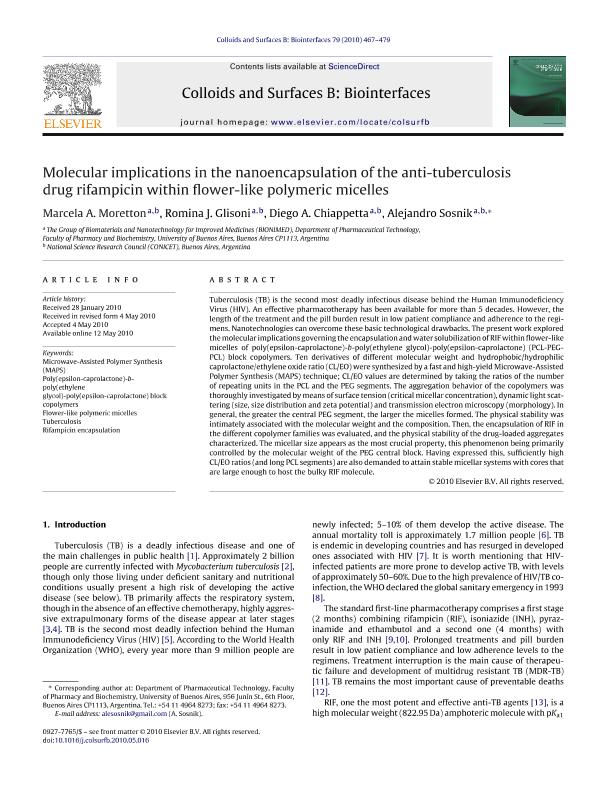Mostrar el registro sencillo del ítem
dc.contributor.author
Moretton, Marcela Analía

dc.contributor.author
Glisoni, Romina Julieta

dc.contributor.author
Chiappetta, Diego Andrés

dc.contributor.author
Sosnik, Alejandro Dario

dc.date.available
2020-09-01T18:02:59Z
dc.date.issued
2010-09
dc.identifier.citation
Moretton, Marcela Analía; Glisoni, Romina Julieta; Chiappetta, Diego Andrés; Sosnik, Alejandro Dario; Molecular implications in the nanoencapsulation of the anti-tuberculosis drug rifampicin within flower-like polymeric micelles; Elsevier Science; Colloids and Surfaces B: Biointerfaces; 79; 2; 9-2010; 467-479
dc.identifier.issn
0927-7765
dc.identifier.uri
http://hdl.handle.net/11336/112915
dc.description.abstract
Tuberculosis (TB) is the second most deadly infectious disease behind the Human Immunodeficiency Virus (HIV). An effective pharmacotherapy has been available for more than 5 decades. However, the length of the treatment and the pill burden result in low patient compliance and adherence to the regimens. Nanotechnologies can overcome these basic technological drawbacks. The present work explored the molecular implications governing the encapsulation and water solubilization of RIF within flower-like micelles of poly(epsilon-caprolactone)-b-poly(ethylene glycol)-poly(epsilon-caprolactone) (PCL-PEG-PCL) block copolymers. Ten derivatives of different molecular weight and hydrophobic/hydrophilic caprolactone/ethylene oxide ratio (CL/EO) were synthesized by a fast and high-yield Microwave-Assisted Polymer Synthesis (MAPS) technique; CL/EO values are determined by taking the ratios of the number of repeating units in the PCL and the PEG segments. The aggregation behavior of the copolymers was thoroughly investigated by means of surface tension (critical micellar concentration), dynamic light scattering (size, size distribution and zeta potential) and transmission electron microscopy (morphology). In general, the greater the central PEG segment, the larger the micelles formed. The physical stability was intimately associated with the molecular weight and the composition. Then, the encapsulation of RIF in the different copolymer families was evaluated, and the physical stability of the drug-loaded aggregates characterized. The micellar size appears as the most crucial property, this phenomenon being primarily controlled by the molecular weight of the PEG central block. Having expressed this, sufficiently high CL/EO ratios (and long PCL segments) are also demanded to attain stable micellar systems with cores that are large enough to host the bulky RIF molecule.
dc.format
application/pdf
dc.language.iso
eng
dc.publisher
Elsevier Science

dc.rights
info:eu-repo/semantics/openAccess
dc.rights.uri
https://creativecommons.org/licenses/by-nc-sa/2.5/ar/
dc.subject
FLOWER-LIKE POLYMERIC MICELLES
dc.subject
MICROWAVE-ASSISTED POLYMER SYNTHESIS (MAPS)
dc.subject
POLY(EPSILON-CAPROLACTONE)-B-POLY(ETHYLENE GLYCOL)-POLY(EPSILON-CAPROLACTONE) BLOCK COPOLYMERS
dc.subject
RIFAMPICIN ENCAPSULATION
dc.subject
TUBERCULOSIS
dc.subject.classification
Otras Nanotecnología

dc.subject.classification
Nanotecnología

dc.subject.classification
INGENIERÍAS Y TECNOLOGÍAS

dc.title
Molecular implications in the nanoencapsulation of the anti-tuberculosis drug rifampicin within flower-like polymeric micelles
dc.type
info:eu-repo/semantics/article
dc.type
info:ar-repo/semantics/artículo
dc.type
info:eu-repo/semantics/publishedVersion
dc.date.updated
2020-08-19T19:39:20Z
dc.journal.volume
79
dc.journal.number
2
dc.journal.pagination
467-479
dc.journal.pais
Países Bajos

dc.journal.ciudad
Amsterdam
dc.description.fil
Fil: Moretton, Marcela Analía. Universidad de Buenos Aires. Facultad de Farmacia y Bioquímica. Departamento de Tecnología Farmacéutica; Argentina. Consejo Nacional de Investigaciones Científicas y Técnicas. Oficina de Coordinación Administrativa Houssay; Argentina
dc.description.fil
Fil: Glisoni, Romina Julieta. Universidad de Buenos Aires. Facultad de Farmacia y Bioquímica. Departamento de Tecnología Farmacéutica; Argentina. Consejo Nacional de Investigaciones Científicas y Técnicas. Oficina de Coordinación Administrativa Houssay; Argentina
dc.description.fil
Fil: Chiappetta, Diego Andrés. Universidad de Buenos Aires. Facultad de Farmacia y Bioquímica. Departamento de Tecnología Farmacéutica; Argentina. Consejo Nacional de Investigaciones Científicas y Técnicas. Oficina de Coordinación Administrativa Houssay; Argentina
dc.description.fil
Fil: Sosnik, Alejandro Dario. Universidad de Buenos Aires. Facultad de Farmacia y Bioquímica. Departamento de Tecnología Farmacéutica; Argentina. Consejo Nacional de Investigaciones Científicas y Técnicas. Oficina de Coordinación Administrativa Houssay; Argentina
dc.journal.title
Colloids and Surfaces B: Biointerfaces

dc.relation.alternativeid
info:eu-repo/semantics/altIdentifier/url/https://www.sciencedirect.com/science/article/abs/pii/S0927776510002559
dc.relation.alternativeid
info:eu-repo/semantics/altIdentifier/doi/http://dx.doi.org/10.1016/j.colsurfb.2010.05.016
Archivos asociados
